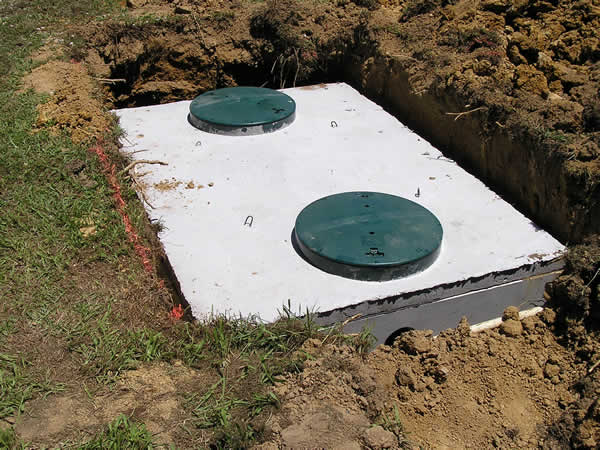
“The Grass is always greener over the septic tank.” – Erma Bombeck
What is a septic tank and drainage field system?
Septic tanks are settling systems for use with flush toilets (and grey water) to achieve a reduction in suspended solid levels prior to disposal and further treatment of the liquid effluent in a drainage field. A drainage field (alternatively a leachfield, percolation area or infiltration area) is an area of ground set out with perforated pipework at specific spacing and elevation to distribute septic tank liquid effluent for treatment within the soil underneath the drainage field pipes.

Both the tank and the drainage field are necessary components in the system. Thus, a septic tank and soak pit, for example, is insufficient as a way to deal with domestic sewage, since the soak pit introduces the effluent in a single point in the ground and does so deep in the ground where the soil cannot act as a physical and biological filter.
The septic tank will need to be emptied of solid waste from time to time (typically annually, by a licenced disposal company), and the soil and soil organisms beneath drainage field will deal with the liquid effluent.
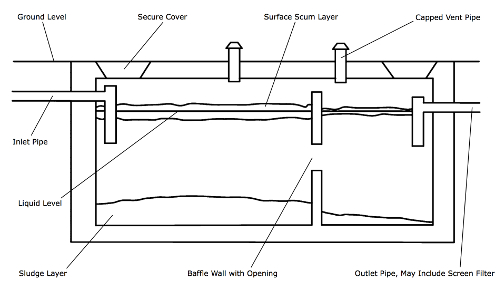
Brief history
Evidence for the earliest flush toilets has been found in India (c.3300-1300BCE), Crete (c.2000BCE) and China (c.200BCE to c.20AD). 1000 years before the flushing system in Crete, dry toilet chambers were in evidence in Mesopotamia, but most of the population preferred to use a chamber pot or the open fields instead.
Fast forwarding through history to the late 1800s, Frenchman Jean-Louis Mouras is credited with building the first septic tank. This was a concrete unit, termed the ‘Mouras Automatic Scavanger’, which was in use for 10 years before being dismantled to check the contents and found to be mostly filled with liquid. He applied for a patent in 1881 and it was based on the success of this system that Donald Cameron brought the technology to England. Cameron improved upon the design and first used the term ‘septic tank’ for his system built in Exeter in 1895. The system was adopted by the local government for use in the city of Exeter a couple of years later and in an eminently practical move, the methane gas from the system was used for heating and lighting at the treatment works (Pullen, Anaerobic Digestion: Making Biogas – Making Energy).
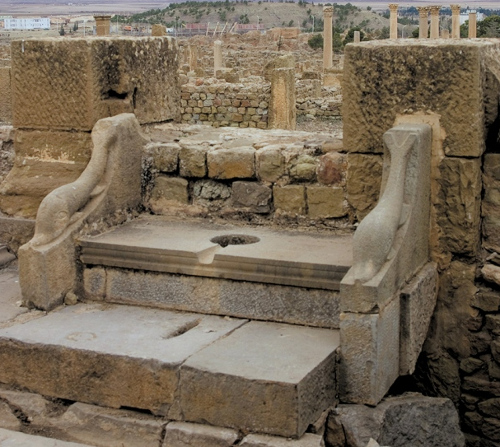
The first UK standards were introduced in the late 1940s and have been subject to modest ongoing revision and amendment up to the present day, and still rely on the same basic principle of anaerobic settlement followed by aerobic treatment in a drainage field. Outside of sewered areas, a septic tank and drainage field is probably the most common sewage treatment system in the UK.
What are the benefits of a septic tank and drainage field?
Like any sanitation system, septic tank and drainage field systems have certain pros and cons, compared to other treatment options.
Pros
- Septic tank and drainage fields are relatively inexpensive and function without electricity where site gradient permits.
- Where suitable soil conditions and depths exist they can provide effective treatment from an environmental perspective, providing roughly the equivalent of secondary treatment (from a mechanical treatment system or reed bed, for example).

Cons
- Not all soils are suitable for septic tank and drainage fields. If your soil is too shallow above either bedrock or groundwater, the filtration distance in the drainage field is insufficient to provide proper treatment, and pollution may occur.
- Proximity to wells, vulnerable aquifers or water courses can render this form of treatment inadequate.
- While septic tanks work well at settling solids, you may simply decide that you’re not happy with that level of treatment, and decide to install secondary treatment (aeration, in a reed bed for example) or tertiary treatment (extended treatment such as sand filtration or an extended reed bed area) rather than just a drainage field alone. Note that for the examples given, the septic tank and drainage field are still necessary for settlement and disposal respectively.
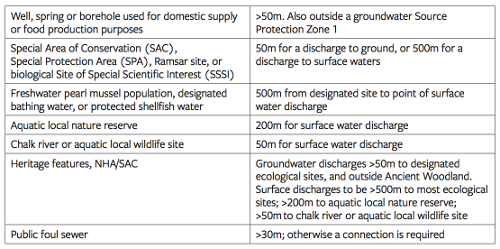
Note that if you already have a septic tank and are thinking of repairing or upgrading your system, consider the following pros and cons as well:
Pros
- Generally less costly than replacement.
- Repair of anything almost always has a lower embodied energy than full replacement. This is particularly the case for energy-intensive materials such as concrete.
- Usually reduces or avoids the disruption of heavy machinery coming into the garden.
Cons
- Can be difficult, unpleasant and potentially hazardous to repair septic tanks.
- Does not necessarily guarantee full compliance with the relevant codes, although it may do so.
- Tank may be discovered to be beyond repair after spending time and money on trying.
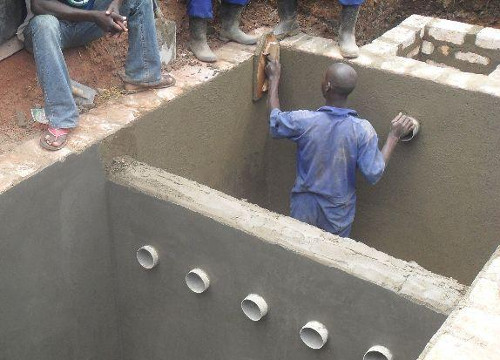
What can I do?
Legal considerations
Planning permission is a legal requirement for any new sewage treatment system, including a septic tank and drainage field system. If you want to install a septic tank and drainage field there are many specialist contractors offering this service. Alternatively if you are adept at construction, you may wish to build the system yourself. In the latter case particularly, it is very important to ensure that you follow the standard guidelines. PPG4 was the UK standard until recently, and has been replaced in England with the General Binding Rules and a similar guidance applies in Wales. Scotland and Northern Ireland still refer to PPG4.
Introduction to how a domestic septic system works.
The relevant guidance documents are as follows:
-
England: Environment Agency. Septic tanks and treatment plants: permits and general binding rules.
-
Wales: Natural Resources Wales. Register your septic tank.
-
Northern Ireland: Northern Ireland Environment’s Agency. Guidance for form WO2 for applications to discharge sewage effluent from single domestic dwellings.
-
Scotland: SEPA’s Regulatory Methods (WAT-RM-03) Sewage Discharges to Surface Waters and (WAT-RM-04) Indirect Sewage Discharges to Groundwater. See also The Water Environment (Controlled Activities) (Scotland) Regulations 2011 (as amended) A Practical Guide.
-
For systems in the Republic of Ireland see the EPA Code of Practice.
In both the PPG4 and UK EA General Biding Rules there are minimum distances that must be adhered to between a sewage treatment system and site features such as watercourses or bedrock etc. These are summarised as set out in Permaculture Guide to Reed Beds:
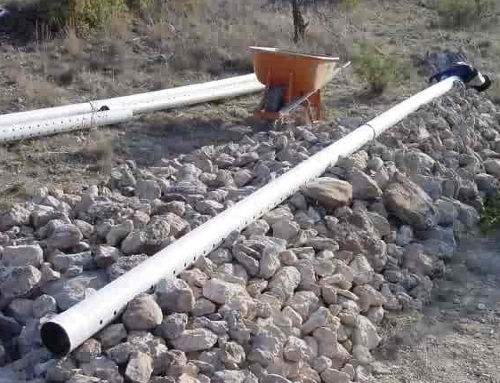
DIY septic tank
A septic tank may be built in situ using concrete blocks as long as it is well plastered and a plasticizer is used to waterproof the render and prevent leakage. Careful attention to detail is needed to ensure that no leakage occurs around inlet or outlet piping. The most notable features in any septic tank are:
- T-pieces at the inlet and outlet pipes to prevent disturbance of the surface scum
- Central baffle wall to create two separate settling chambers
- Secure access to the tank
- Vent piping.
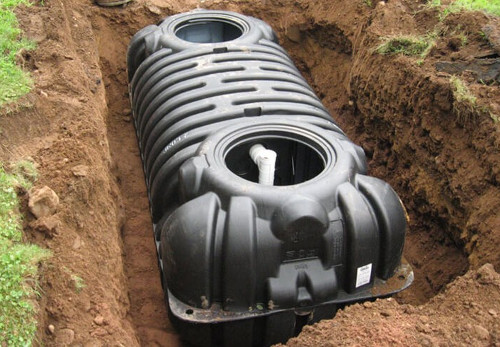
The tank must be waterproof and have a safe cover. The size of the tank and drainage field should typically be based on bedroom numbers in the house it serves. PPG4 provides guidance on these – it recommends a minimum tank size of 2700 litres for 4 persons (2 bedroom house) and drainage field calculations based on the percolation value in your soil. The percolation test information is provided in PPG4 if you want to carry this out yourself.
When you are building or installing your septic tank ensure that there is a steady fall from the house to the tank and then from the tank to the drainage field. If your site topography is unsuitable for using gravity to convey the sewage to the tank, then you may wish to use a dry toilet to avoid using electricity to pump effluent up to your drainage field or tank.
See the further info section for more details on laying out a septic tank and leachfield.
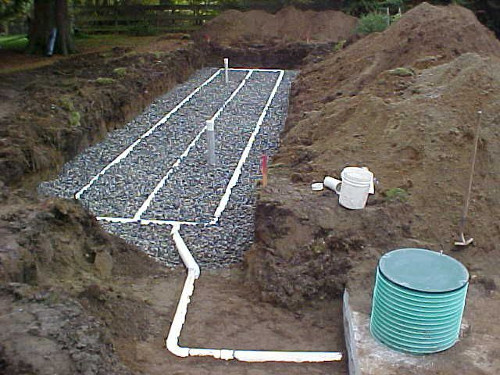
Improving on the standard system
If you want to upgrade your septic tank and drainage field system there are a number of options available to you. To improve the effluent quality you may wish to use a reed bed system prior to the drainage field. To recoup biomass and nutrients you may wish to use a compost toilet and then have a separate drainage field or reed bed for grey water from the sinks and washing machines. To follow the example of Donald Cameron’s system in Exeter you may wish to recoup methane as a fuel for cooking or heating. To do this you’ll need a modified tank design to allow for insulation and reduced liquid inputs.

One easy way to recoup biomass and nutrients from a standard system is to plant a biomass crop over the drainage field. Biomass willow and comfrey are the two plants that I most recommend. Willows have a very high growth rate and an impressive uptake of both liquid and nutrients from sewage effluent. They have been used in Denmark since the mid-1990s for zero discharge willow systems to dispose of 100% of the effluent pumped into them. Willows also work well as a filter plant for use within a modified drainage field layout. Modifications are needed to the piping network to prevent root ingress into the pipes causing them to clog up completely. Comfrey is well known as a nutrient accumulator, drawing up potassium and other nutrients from deep within the soil and making them available in leaf litter or harvested leaves which can be added to a compost heap. They are excellent plants for use over existing percolation areas insofar as their roots are considerably less invasive than willows, and yet they can draw up the nutrients that would otherwise be lost to the ground, and ultimately migrate into the groundwater and surrounding environment.
Thanks to Feidhlim Harty of FH Wetland Systems for information and pics.
The specialist(s) below will respond to queries on this topic. Please comment in the box at the bottom of the page.

Féidhlim Harty is an environmental consultant and writer, and director of FH Wetland Systems Ltd., a company specialising in wetland and reed bed design, willow systems and habitat enhancement. He is the author of Septic Tank Options & Alternatives and Permaculture Guide to Reed Beds, both published by Permanent Publications.
The views expressed here are those of the author and not necessarily lowimpact.org's
2 Comments
-
1Diarmuid O'Reilly July 1st, 2020
Good article. Every day is a school day as we learn something new. I’d never heard of the use of Comfrey.
-
2Thomas Clarence November 28th, 2023
I thought it was interesting when you mentioned that there are a number of ways to upgrade a septic system. With that in mind, I would think that it would be a good idea to avoid the temptation to perform a septic system upgrade by yourself. Hiring a professional means that all of the systems will be connected properly in your septic tank.




 Biogas
Biogas
 Compost toilets
Compost toilets
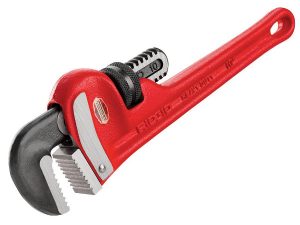 Plumbing
Plumbing
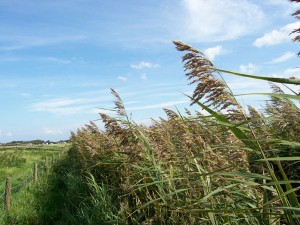 Reed beds
Reed beds
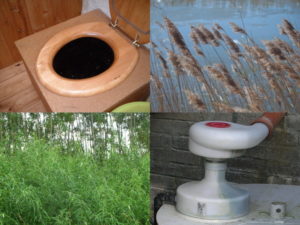 Low-impact sewage treatment
Low-impact sewage treatment
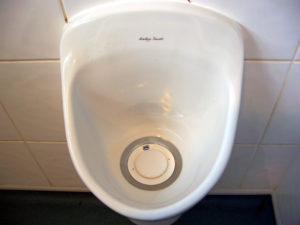 Waterless urinals
Waterless urinals


